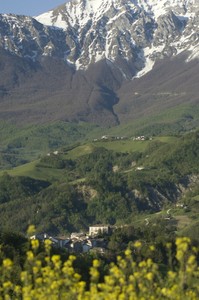Arsita
| Information |
|---|
| Map and contacts |
| Events |
| Val Fino al Canto |
| Museums |
| The Wolf Museum of Arista |
“Arso” meaning “burnt”, Arsita means a “Burnt space”. This was the name given to Arsita in the XI century. It rises on a small hill in the heart of the Fino Valley, where the Vestini people had once settled. Numerous historical testimonies of these ancient origins have been preserved: rests of archaic graves, statues and coins, a Necropolis of “a cappucino” tombs containing cinerary urns and various equipments.
In the Middle Ages the lot of Arsita was bound to conflicts which opposed aristocratic families for dominion over land. It was first contended by the Counts of Chieti, than by the Monks of Montecassino, by the Lords of Bisenti and Acquaviva and was finally annexed to the fief of the House of Este.
This explains its typical fortified structure. Some parts of the city walls (XII-XII century), reinforced by “U” towers and a circular angle tower standing in the north sector, still remain from the small Castello Bacucco. This fortification, similar to a “castello recinto”, a small apical castle enclosed into walls, was probably transformed into an aristocratic residence during the 18th century and has kept this aspect ever since. However, some largely mutilated parts of it show the state of abandon it suffers from today.
Among the sites worth visiting is the church of S.Vittoria. Its clearly 18th-century structure, is characterised by one sole nave and lateral ædicules containing statues (such as the statue S.Nicola di Bari, Patron of Arsita) and an oval painting dating from the same period, which represents the Madonna della Grazie towering above the S.Vittoria.
The gentilitial chapel of the SS. Trinità stands right outside the church. The portal is enriched by wooden doors with carved caissons representing typical popular style angels and sea monsters.
Finally, right outside the village are the rests of the 16th-century Church of Santa Maria D'Aragona, which bears today evident signs of modern additions on its façade and structural damages along the sides. In this same church was found a terracotta Madonna con Bambino with articulated hands and mobile body. This peculiar terracotta dating back to 1531 was restored in recent times and is now in the parish church.

















